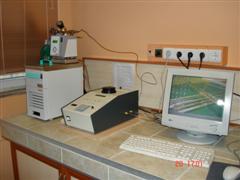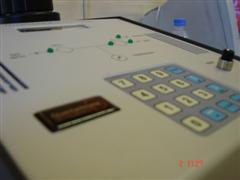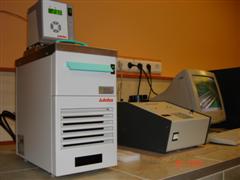“Pycnometry” is derived from the Greek word pyknos, which has long been identified with volume measurements. The pycnometers from Quantachrome are specifically designed to measure the true volume of solid materials by employing Archimedes’ principle of fluid (gas) displacement and the technique of gas expansion.
Ideally, a gas is used as the displacing fluid since it penetrates the finest pores assuring maximum accuracy. For this reason
The pycnometers from Quantachrome are specifically designed to measure the true volume of solid materials by employing Archimedes’ principle of fluid (gas) displacement and the technique of gas expansion.
Ideally, a gas is used as the displacing fluid since it penetrates the finest pores assuring maximum accuracy. For this reason  helium is recommended, since its small atomic dimension enables entry into crevices and pores approaching two Angstrom (2x10-10m). Its behavior as an ideal gas is also desirable. Other gases such as nitrogen can be used, often with no measurable difference.
Applications
Quantachrome pycnometers are used for research, development and quality control in such diverse industries as carbon black, catalysts, cement, ceramics, charcoals, cosmetics, desiccants, fertilizers, fibers, fillers, insulating and structural foams, powdered foods, ion exchange resins, minerals such as alumina, silica, titania and others, nuclear fuels, petrochemicals, pharmaceuticals and powdered metals. Pycnometry can even determine the percentage of solids in a slurry.
helium is recommended, since its small atomic dimension enables entry into crevices and pores approaching two Angstrom (2x10-10m). Its behavior as an ideal gas is also desirable. Other gases such as nitrogen can be used, often with no measurable difference.
Applications
Quantachrome pycnometers are used for research, development and quality control in such diverse industries as carbon black, catalysts, cement, ceramics, charcoals, cosmetics, desiccants, fertilizers, fibers, fillers, insulating and structural foams, powdered foods, ion exchange resins, minerals such as alumina, silica, titania and others, nuclear fuels, petrochemicals, pharmaceuticals and powdered metals. Pycnometry can even determine the percentage of solids in a slurry.
The ULTRAPYCNOMETER 1000 from Quantachrome are the ultimate instruments for measuring the true volume and density of powders, foams and bulk solids. A wide range of sample cell sizes are easily interchanged to accommodate many different samples. Calibration, sample conditioning, operation of valves and calculation of results are completely automatic. Samples are quickly and automatically analyzed as many times as necessary to achieve the user desired % deviation from mean at the specified number of runs. Should the deviation setting be too narrow, the analysis terminates upon
reaching an operator specified maximum number of runs. The
results are printed automatically, freeing the operator to perform
other laboratory tasks.
accommodate many different samples. Calibration, sample conditioning, operation of valves and calculation of results are completely automatic. Samples are quickly and automatically analyzed as many times as necessary to achieve the user desired % deviation from mean at the specified number of runs. Should the deviation setting be too narrow, the analysis terminates upon
reaching an operator specified maximum number of runs. The
results are printed automatically, freeing the operator to perform
other laboratory tasks.
For measurements that require a fixed, known temperature, a temperature control option is available for both the ULTRAPYCNOMETER 1000.
For measurements in a hazardous environment, such as a nuclear “hot cell”, a remote operation ULTRAPYCNOMETER 1000 is available.
 helium is recommended, since its small atomic dimension enables entry into crevices and pores approaching two Angstrom (2x10-10m). Its behavior as an ideal gas is also desirable. Other gases such as nitrogen can be used, often with no measurable difference.
Applications
Quantachrome pycnometers are used for research, development and quality control in such diverse industries as carbon black, catalysts, cement, ceramics, charcoals, cosmetics, desiccants, fertilizers, fibers, fillers, insulating and structural foams, powdered foods, ion exchange resins, minerals such as alumina, silica, titania and others, nuclear fuels, petrochemicals, pharmaceuticals and powdered metals. Pycnometry can even determine the percentage of solids in a slurry.
helium is recommended, since its small atomic dimension enables entry into crevices and pores approaching two Angstrom (2x10-10m). Its behavior as an ideal gas is also desirable. Other gases such as nitrogen can be used, often with no measurable difference.
Applications
Quantachrome pycnometers are used for research, development and quality control in such diverse industries as carbon black, catalysts, cement, ceramics, charcoals, cosmetics, desiccants, fertilizers, fibers, fillers, insulating and structural foams, powdered foods, ion exchange resins, minerals such as alumina, silica, titania and others, nuclear fuels, petrochemicals, pharmaceuticals and powdered metals. Pycnometry can even determine the percentage of solids in a slurry.
The ULTRAPYCNOMETER 1000 from Quantachrome are the ultimate instruments for measuring the true volume and density of powders, foams and bulk solids. A wide range of sample cell sizes are easily interchanged to
For measurements that require a fixed, known temperature, a temperature control option is available for both the ULTRAPYCNOMETER 1000.
For measurements in a hazardous environment, such as a nuclear “hot cell”, a remote operation ULTRAPYCNOMETER 1000 is available.